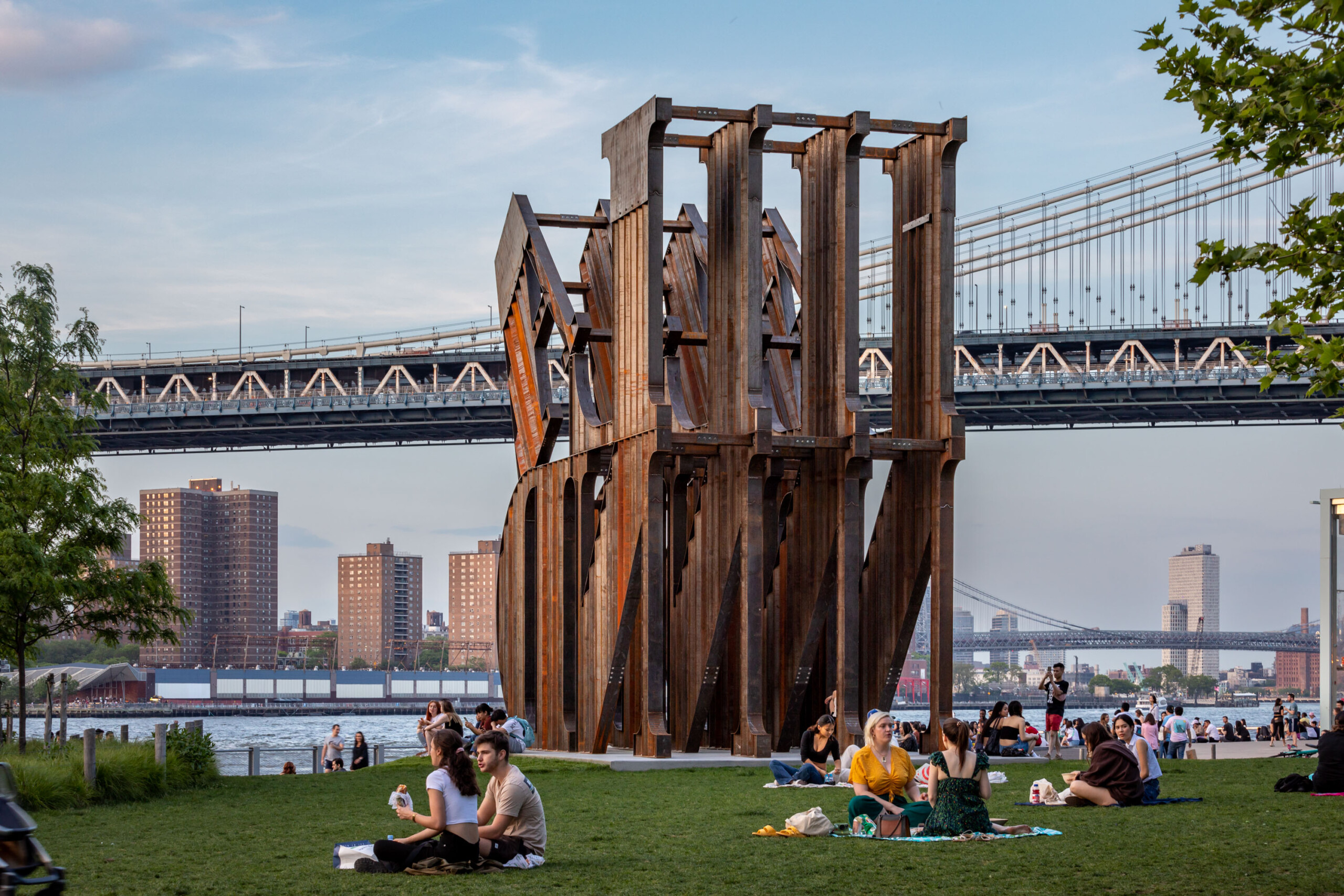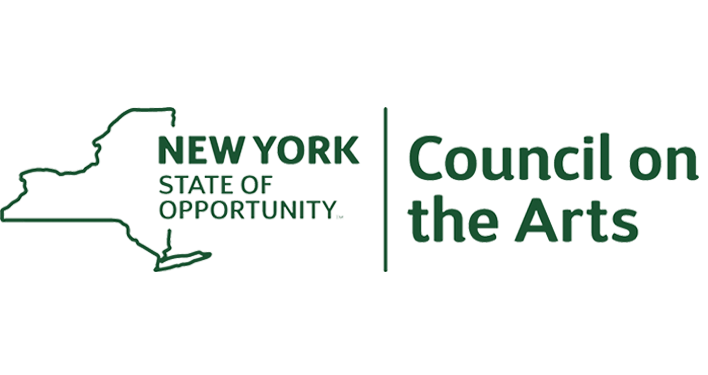Nicholas Galanin created this work with the same steel tubing used to construct the U.S.-Mexico border wall, also echoing its 30-foot height. The metal was cut and reassembled to spell out LAND in a format reminiscent of Robert Indiana’s 1966 sculpture, LOVE. The anti-climbing plate seen atop the border wall appears here on the upper letters, and the text repeats in four layers to create a dynamic, open structure. As our point of view changes, the text shifts between legibility and abstraction.
Galanin is a member of the Sitka Tribe of Alaska (b.1979 Sitka; Lingít and Unangax̂). As an Indigenous person, he practices subsistence in his homeland. For him, the free movement of life is essential, and all life is deeply connected to Land. Galanin adapts aspects of pop art and minimalism, such as repetition, text, and industrial production to protest oppressive systems of division and control. The title, In every language there is Land / En cada lengua hay una Tierra, combines English and Spanish, two languages imposed in North America since colonization. The work reminds us that Indigenous peoples persist and permeate borders despite the forcible removal of rights, languages, and access to Land and Water. For Galanin, “barriers to Land directly reflect barriers to love, love for Land, for community and for future generations.”
Nicholas Baume
Artistic & Executive Director, Public Art Fund
About the Artist
Nicholas Galanin (b. 1979, Sitka, AK) creates art rooted in his perspective as an Indigenous man connected to the land and culture to which he belongs. His work is embedded with incisive observation and critical thinking to advocate for social and environmental justice. Through concept, form, image, and sound, Galanin expands and refocuses the intersections of culture, centering Indigeneity. His works are vessels for knowledge, culture and technology—inherently political, generous, unflinching, and poetic. Deftly engaging with past, present and future, Galanin celebrates the beauty, knowledge and resilience of Indigenous people. Avoiding binaries and categorization, Galanin’s multilayered practice seeks to envision, build and support Indigenous sovereignty.
Over the past two decades Galanin’s work has ranged across media, materials and processes, including powerful examples of public art. In 2020 Galanin excavated the shape of the shadow of the Capt. James Cook statue in Hyde Park for the Biennale of Sydney, examining the effects of colonization on land, critiquing anthropological bias, and ultimately suggesting the burial of the statue and others like it. In 2021 he created an analog to the Hollywood sign for the Desert X Biennial in Palm Springs CA, which reads “INDIAN LAND”, directly advocating for and supporting the Land back and Real Rent initiatives. Ultimately, his practice invites us to analyze and rethink the assumptions of embedded power structures and revalue those of Indigeneity, including care for land, community, and future generations.
Galanin holds a BFA from London Guildhall University in Jewellery Design and an MFA in Indigenous Visual Arts from Massey University in New Zealand, prior to which he apprenticed with master carvers and jewelers in his community; he is represented by Peter Blum Gallery in New York, and his music is released by Sub Pop Records in Seattle. Galanin lives and works with his family on Lingít Aani, Sitka, Alaska.
Hear more from the artist! Visit the Public Art Fund digital guide on the free Bloomberg Connects app for exclusive audio content on this exhibition (type in lookup #4)
Installation Photos
Location
Para crear esta obra, Nicholas Galanin usó la misma tubería de acero utilizada en la construcción del muro fronterizo entre México y Estados Unidos, haciendo también eco a sus 30 pies de altura. El metal se cortó y volvió a ensamblar formando la palabra LAND, en un formato que recuerda a la escultura LOVE, de Robert Indiana de 1966. La placa que se ve sobre el muro fronterizo para evitar que sea escalado aparece aquí en las letras superiores, y el texto se repite en cuatro capas para crear una estructura dinámica y abierta. Conforme nuestro punto de vista cambia, el texto va de lo legible a lo abstracto.
Galanin forma parte de la tribu Sitka de Alaska (n.1979 Sitka; Lingít y Unangax̂). Como persona indígena, practica la subsistencia en su tierra natal. Para él, el libre movimiento de la vida es esencial y toda vida está profundamente conectada a la tierra. Galanin toma elementos del pop art y el minimalismo, como la repetición, el texto y la producción industrial, para protestar en contra de los sistemas opresivos división y de control. El título, In every language there is Land / En cada lengua hay una Tierra, combina inglés y español, ambos idiomas impuestos en América del norte desde la colonización. La obra nos recuerda que los pueblos indígenas persisten y permean las fronteras a pesar de la eliminación forzosa de sus derechos, lengua y acceso a la Tierra y al Agua. Para Galanin, “las barreras a la Tierra reflejan directamente las barreras al amor: amor por la Tierra, por la comunidad y por las generaciones futuras”.
Nicholas Baume
Director artístico y ejecutivo, Public Art Fund
Acerca del artista
La obra de Nicholas Galanin (n. 1979, Sitka, AK) está arraigada en su experiencia como hombre indígena conectado con la tierra y la cultura a la que pertenece, impregnada de observación incisiva y pensamiento crítico que aboga por la justicia social y ambiental. A través del concepto, la forma, la imagen y el sonido Galanin expande y reenfoca las intersecciones de la cultura, poniendo lo indígena al centro. Sus obras son repositorios para el conocimiento, la cultura y la tecnología, inherentemente políticas, generosas, inquebrantables y poéticas. Dialogando hábilmente con el pasado, el presente y el futuro, Galanin celebra la belleza, el conocimiento y la resiliencia de los pueblos indígenas. Al evitar binarios y categorizaciones, la práctica multifacética de Galanin busca visualizar, construir y apoyar la soberanía indígena.
Durante las últimas dos décadas, su obra ha variado en cuanto a medios, materiales y procesos, incluyendo importantes ejemplos de arte público. En 2020, Galanin excavó la forma de la sombra de la estatua del capitán James Cook en Hyde Park para la Bienal de Sídney, examinando los efectos de la colonización en la tierra, criticando el sesgo antropológico y, en última instancia, sugiriendo que se enterrara esa y otras estatuas similares. En 2021, creó un análogo al letrero de HOLLYWOOD para la Bienal Desert X en Palm Springs CA, que decía “INDIAN LAND”, defendiendo y apoyando directamente las iniciativas Land back y Real Rent. Su práctica nos invita a analizar y repensar los valores establecidos por las estructuras de poder dominantes y a revalorar aquellos del mundo indígena, incluyendo el cuidado de la tierra, la comunidad y las generaciones futuras.
Galanin tiene un BFA en Diseño de Joyería de London Guildhall University y un MFA en Artes Visuales Indígenas de Massey University en Nueva Zelanda, previo a lo cual fue aprendiz con maestros talladores y joyeros en su comunidad. Está representado por Peter Blum Gallery en Nueva York, y su música es editada por Sub Pop Records en Seattle. Galanin vive con su familia y trabaja en Lingít Aani, Sitka, Alaska.
 Menu
Menu






